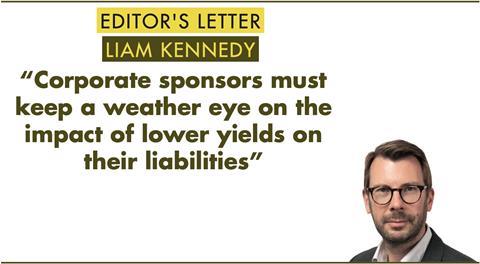The final two months of 2023 saw a return to form for global fixed income and equities, with respectable single and double-digit numbers in each case. After a false start in early 2023, at least for a multitude of asset forecasters, bonds were finally back in the final months of last year.

This has been a welcome outturn for corporate sponsors of DB schemes in terms of asset performance.
Funding positions for all types of pension schemes have also improved in recent years.
According to WTW’s Swiss Pension Finance Watch, the funding position of a typical Pensionskasse in Switzerland has improved from 105.2% in December 2019 to 119.9% in December 2023. In the UK, the average funding ratio for the universe of just over 5,000 DB schemes assessed by the Pension Protection Fund has increased to 142.8%.
A similar picture prevails in other DB systems. In Germany, where a large slug of pension liabilities has been held on corporate balance sheets and historically not backed by assets, funding for the leading DAX 40 companies now exceeds 80%.
Inflation looks to have been tamed, if not fully controlled, and investors have priced in rate cuts in 2024. The strong performance of bonds has also led to a decrease in yields and therefore in the discount rates used to measure pension liabilities.
Indeed, average pension funding levels softened in Switzerland in late-2023, and the trajectory for 2024 will depend on the outlook for corporate and government bond yields, from which discount rates are derived.
Corporate sponsors and their trustees must be mindful of the implications of potentially lower bond yields for their liabilities, and of the continuing ability of pensions to impact corporate balance sheets.
In a January briefing, PIMCO sees a positive outlook for liquid, high-quality credit in 2024, but is more cautious on private credit.
For many sponsors, the question will be when, not if, to offload pension liabilities to insurers. So far, this has been confined to the UK, with some activity elsewhere. Now there are predictions for greater interest in pension risk transfer in markets like Ireland and Germany.
In Ireland, enhanced pressure from the regulator on governance could encourage some sponsors to opt for buyout. From a regulatory perspective this would be welcome because it would imply a form of consolidation and more streamlined scrutiny of a historically atomised DB market.
In Germany, Allianz Global Investors has teamed up with Deutsche Betriebsrenten Holding in the expectation of increased interest from Germany corporates in the transfer of pension risk to the insurance sector. The model, as outlined in this month’s Special Report, is to create a captive corporate structure, which is then acquired by the insurance entity.
Of course, the transfer of liabilities to insurers is not without its pitfalls for sponsors or members. The UK experience shows that a restricted pipeline for buy-in or buyout deals with insurance balance-sheet capacity is a key issue. Timing is also a factor – and another reason why trustees and sponsors should keep an eye on the bond market, yields and future discount rates.
Many have initial agreements in place with insurers so they are ready to transact when the market timing is right. Close attention needs to be paid to hedge liabilities against further interest rate falls, and the optimal level of liquidity.
But the complexity of transactions is becoming a concern for regulators, particularly when balance-sheet capacity of insurers is restricted, reinsurance of risk is limited to a few global players, offshore jurisdictions like Bermuda are becoming involved, and hedge funds are in the mix.
Members may be unaware of the complex web of transactions that underlies their pension entitlement. But unions are becoming more attuned to the fact that risk transfer deals may undermine the social solidarity aspect of pensions – for instance where inflation indexation may historically be conditional and in the hands of trustees. Unions may push back.
Against this backdrop, it may be attractive to maintain the existing trustee-based pension scheme and run the liabilities off over time, as if it were a captive annuity book but without the burden of solvency rules.
This is not a hands-off exercise: sponsors going for this option should focus on the operational resilience of the fund – particularly in risk and counterparty management. Some form of delegated decision-making is advisable, either to a well-resourced in-house team or to an external fiduciary manager.
Good governance will be paramount whichever path a pension schemes follows.
Liam Kennedy, Editor
liam.kennedy@ipe.com








































No comments yet